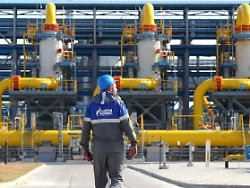Monday, November 8th, 2021
Energy crisis in Europe
Gazprom continues to open the gas tap
Shortly before the onset of winter, gas storage facilities in Europe are poorly filled. Kremlin chief Putin instructs Gazprom to open the valves further. As of today, the energy supplier should deliver even more than the agreed mandatory quantities to the West. Does that mean the gas crisis is history?
After months of the energy crisis, gas customers in Europe can hope for additional energy supplies from Russia from this week on. It has been almost two weeks since Russian President Vladimir Putin, under pressure from rising prices and poorly filled storage facilities, instructed the state gas giant Gazprom to replenish the reserves in Germany and Austria. First the domestic supplies should be replenished. But now Gazprom should also open the valves for Europe further.
Russia’s state media cheered that Putin was the “savior in the gas crisis” and was protecting the EU from the cold shock. Shortly before the start, a spokesman for Putin confirmed that the plan was in place and that Gazprom would deliver more than the agreed mandatory quantities after November 8th. The Federal Association of Energy and Water Industries had also welcomed Moscow’s announcement. At the end of October, according to the association, the plants supplied by Gazprom in Germany were only 21 percent full, below average compared to other gas storage facilities.
Meanwhile, there is still great anger in Russia over allegations that the country is driving up prices by withholding gas. As Russia’s most important woman in gas exports, Jelena Burmistrowa has just decidedly rejected responsibility for the energy crisis on the international stage. At a conference in Amsterdam earlier this month, the head of Gazprom Export said anyone who “speculates about Gazprom’s malicious acts” is far from reality.
Ukraine is dependent on transit revenue
Russia kept pointing out that there was a gas crisis around the world. The reasons lie in the recovery of the economy after the restrictions caused by the pandemic. There is a hunger for energy, especially in Asia. Last but not least, the US would have preferred to deliver additional liquefied gas there and not to Europe, said Burmistrowa. Kremlin chief Putin had accused the Europeans of neglecting to properly fill their gas storage facilities after a cold winter. To make matters worse, because of a lull in the wind in the North Sea, the wind turbines produced less electricity there. More gas had to be converted into electricity. This also reduced storage reserves.
Nonetheless, Russia found itself exposed to political accusations in Germany and other EU countries that deliveries were in short supply in order to bring about the rapid commissioning of the finished Nord Stream 2 pipeline in the Baltic Sea. The Kremlin urged that Nord Stream 2 could ease the situation. But Moscow also stressed that regardless of this, all agreed quantities would be delivered. Customers in the West also confirmed that Russia delivers reliably. It is not at all disputed that the raw materials giant is fulfilling its contracts. Rather, the point of contention is whether Russia is really doing everything it can to deliver additional quantities. Putin himself made it clear that there were limits for him. For example, Gazprom wants to forego Ukraine as the most important transit country for Russian gas supplies to Europe for a long time.
The route through Ukraine is longer and therefore more expensive; In addition, the Ukrainian transmission network was ailing and could not withstand the higher pressure caused by transit, said Putin. Ukraine’s offers to lower the fees came to nothing. The impoverished country urgently needs the income from transit. As Vice President of Gazprom, Burmistrowa also stated at the Amsterdam conference that Russia was not interested in extremely high gas prices. The “record prices” could accelerate the transition to renewable energies in the EU.
Russia wants to link gas prices to oil
The huge empire, which is dependent on petrodollars, wants to earn money for its national budget with fossil fuels for a long time to come. Putin spoke out several times in favor of a return to long-term contracts, because this would give Russia planning security for the development of new deposits. The gas price should therefore be linked to that for oil. Russia is also increasingly producing liquefied gas and can therefore react more quickly to acute situations. “In contrast to the flexible suppliers of liquefied gas, we are firmly bound to Europe through our pipeline system,” said Burmistrowa. The fact that a gas pipeline built for more than ten billion euros has not yet been released for operation only triggers uncomprehending shaking of the head in Russia.
55 billion cubic meters of gas per year should flow to Europe in the future. However, there is no start date due to pending approvals. Meanwhile, the Russians emphasize that, in view of the gas crisis, they have already delivered more than agreed. Exports to Germany alone increased by 30 percent in the first nine and a half months compared to the same period in the previous year, it said. Germany is the largest Gazprom customer in the EU. The country bought around 46 billion cubic meters of gas from Russia in 2020 – around a third of all consumption in Germany. Still, that’s not enough.
However, there is currently no threat of a collapse in supply in Europe. Analysts believe that the storage facilities in Europe are currently still filled with around 82 billion cubic meters or 76 percent of active gas. That is about 15 percentage points less than the average level for the past five years. But Gazprom’s storage facilities in Germany and Austria, as CEO Alexej Miller admitted in a conversation with Putin, had hardly any gas left. Therefore it is now being delivered.
